THE
STORY OF THE REAL BALTO
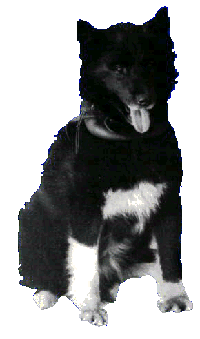 Thanks to a bit of mis-information
and some curiosity on my part, I have obtained information as
well as pictures about what happened to the real Balto. The
following page includes several pictures (that may be viewed full
size) that were taken during the course of the 1925 "Mercy
Race to Nome".
Thanks to a bit of mis-information
and some curiosity on my part, I have obtained information as
well as pictures about what happened to the real Balto. The
following page includes several pictures (that may be viewed full
size) that were taken during the course of the 1925 "Mercy
Race to Nome".
Special thanks are due to
the Cleveland Museum of Natural History for replying to my letter
with a big envelope full of cool Balto stuff!!
Nome, Alaska appeared on the map during one
of the world's great gold rushes at the end of the century.
Located on the Seward Peninsula, by 1900 the town's population
had swelled to 20, 000 after gold was discovered on beaches along
the Bearing Sea. By 1925, however, much of the gold was gone, and
scarcely 1, 400 people were left in the remote nothern outpost.
Nome was icebound seven months of the year and the nearest
railroad was more than 650 miles away, in the town of Nenana.
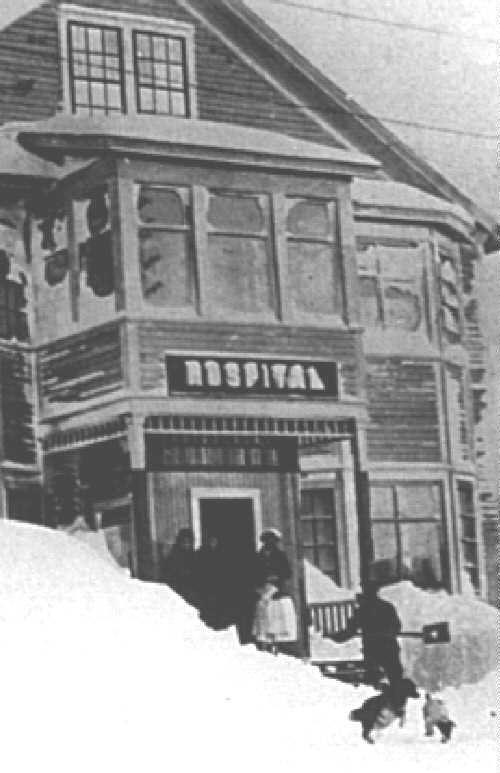 Nome was able to communicate with
the rest of the world via the radio telegraph, a relatively new
invention in those days. And, although Alaska was still a U.S.
Territory until 1959, the government maintained a route over
which relays of dog teams carried mail from Anchorage to Nome. A
one-way trip along this route, called the Iditerod Trail, took
about a month and the "mushers" that traversed the
trail were the best in Alaska.
Nome was able to communicate with
the rest of the world via the radio telegraph, a relatively new
invention in those days. And, although Alaska was still a U.S.
Territory until 1959, the government maintained a route over
which relays of dog teams carried mail from Anchorage to Nome. A
one-way trip along this route, called the Iditerod Trail, took
about a month and the "mushers" that traversed the
trail were the best in Alaska.
A Race For Life!
On January 20, 1925, a
radio signal went out, flashing for miles across the frozen
tundra:
Nome calling... Nome calling... We have
an outbreak of diphtheria... No
Serum... Urgently need help... Nome
calling... Nome calling...
Nome's only doctor had
diagnosed cases of diphtheria, an extremely contageous disease
affecting the throat and lungs, which can easily reach epidemic
proportions. The Inuit Indians were particularly vulnerable.
Whole villiages had been wiped out by earlier epidemics of
measles and flu. The frantic search for antitoxin began:
Seattle calling... Seattle calling... Fresh
serum available here... Airplanes standing
by to fly to Nome...
January 25
The long twilight
of the arctic winter had settled over Nome. Heavy snow had fallen
and temperatures dropped far below zero. These weather conditions
were beyond the technical capabilities of early airplanes with
open cockpits.
Anchorage calling... Anchorage calling...
300,000 units of serum located
in railway hospital here... Package can be
shipped by train to Nenana... Package
weighs 20 pounds... Could serum be
carried to Nome on Iditerod Trail by
mail drivers and dog teams?
Yes! Even though it was
the 20th century, some problems could not be solved with
machines. For years the settlers of Alaska had trusted in
courageous men and strong dogs. They would trust in them again.
By the next day, three
children in Nome had died of diphtheria and more cases had been
diagnosed. Time would be a matter of life and death. A relay of
dog teams along the Iditerod Trail was quickly organized.
January 27
The serum arrived
in Nenana by train, and the relay to the stricken city began.
"Wild Bill" Shannon lashed the life-saving cargo to his
sled and set off westward. Except for the dogs' panting and the
swooshing of runners on the snow, there were no other sounds on
the trail. The temperature was dropping fast. It was 30 degrees
below zero when Shannon started. Then it fell to 35 degrees... 40
degrees... 45 degrees... and finally 50 degrees below in the
arctic darkness. Shannon rushed on, mindless of the cold, until
he handed the serum over to Edgar Kalland in Tolovana, 52 miles
from Nenana.
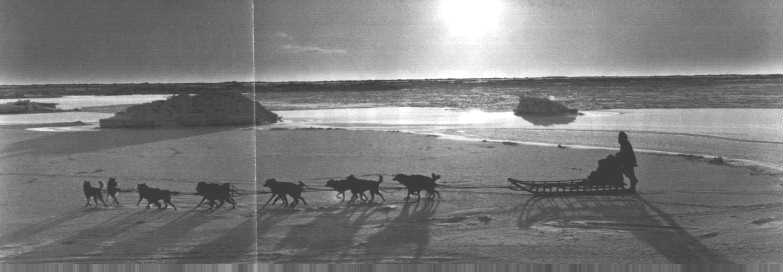
January 28
Kalland, in turn,
passed the serum to Dan Green at Manley Hot Springs (31 miles).
Green took it to Fish Lake (28 miles), averaging an astonishing
nine miles an hour. From Green it passed to Johnny Folger (26
miles). He passed it on to Sam Joseph (34 miles), then to Titus
Nikolai (24 miles) and Dave Corning (30 miles).
New snow fell and the wind
picked up, creating whiteouts, but on and on the mushers went:
Harry Pitka (30 miles), Bill McCarty (28 miles), and Edgar
Nollner (24 miles). Eskimo, Indian, and white mushers carried
serum in the "Great Race of Mercy."
The relay teams were
challenging the limits of endurance. From frozen hands to frozen
hands the serum passed, itself frozen until thawed out in one of
the shelters, only to freeze solid again on the trail.
January 30
At Galena, Edgar
Nollner gave the serum to his newly married brother, George. The
young Indian chanted Athabascan love songs through the wilderness
to keep warm in the minus 50° weather. On his 30-mile stretch,
Charlie Evans harnessed himself to the sled when two dogs froze
on their feet.
The serum passed on to
Tommy Patsy (36 miles); Jackscrew, the Koyukuk Indian (40 miles);
Victor Anagick (34 miles); Myles Gonangnan (40 miles). Men and
dogs used their own bodies to break trail through four-foot snow
drifts.
January 31
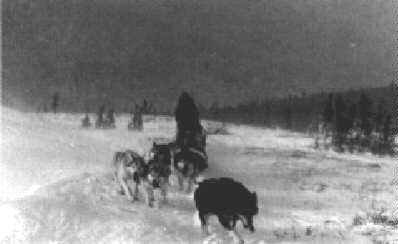 At
Shaktolik, Henry Ivanoff had traveled a half-mile along the trail
when his team darted after a reindeer. While untangling the dogs,
the Russian Eskimo spotted Leonard Seppala, the greatest musher
in the territory, and Togo, one of the territory's greatest dogs,
rushing down the trail. Due to a breakdown in communications,
Seppala and his famous Siberian huskies had set out from Nome,
150 miles away, to meet the relay and return with the serum. The
serum was handed off to Seppala, who mushed 91 miles to the next
relay point.
At
Shaktolik, Henry Ivanoff had traveled a half-mile along the trail
when his team darted after a reindeer. While untangling the dogs,
the Russian Eskimo spotted Leonard Seppala, the greatest musher
in the territory, and Togo, one of the territory's greatest dogs,
rushing down the trail. Due to a breakdown in communications,
Seppala and his famous Siberian huskies had set out from Nome,
150 miles away, to meet the relay and return with the serum. The
serum was handed off to Seppala, who mushed 91 miles to the next
relay point.
Each dog on a team has an
important position, but it is the leader that must guide them
through safely. In addition to having courage and endurance, a
leader like Togo must be obediant and have an uncanny instinct to
find the trail and sense danger.
As the storm grew more
vicious, Seppala was faced with the decision of whether to take a
shortcut across frozen, and yet dangerous, Norton Sound or to go
around it. Gale-force winds hurled seawater over the ice, which
threatened to break up at any moment. But Seppala was confidant
of his team, and Togo unearringly led them across the jagged,
groaning ice floes to the safety of land. Just three hours later,
the ice broke in Norton Sound.

February 1
Through blinding
snow and hurricane force winds, the desperately needed serum was
passed from Seppala to Charlie Olson (25 miles) and then to
Gunnar Kaasen. Had Kaasen an inkling of how wild the storm would
rage, he would not have chosen Balto to lead his team out of
Bluff. Although Balto was one of Seppala's dogs, he simply was
not thought of as a very good leader. But Balto proved his mettle
when he plunged into the roaring blizzard, at one point halting
to save driver and team from instant death in the Topkok River.
No one believed Kaasen
would make it through the storm, so when he arrived at the Safety
Shelter, 21 miles from Nome, he found the next driver asleep. The
team was running well and so they forged ahead. Their endurance
was tested even further when a sudden, fierce blast of wind
lifted both sled and dogs into the air. While fighting to right
the sled and untangle the team, Kaasen's heart sunk - the serum
was gone! Only after frantically searching the snow with his bare hands did he
miraculously find it.
February 2
Before daybreak on
February 2, 1925, Balto led Gunnar Kaasen's team into Nome. The
town was saved! Exhausted and nearly frozen after the 53-mile
run, Kaasen, Balto and the rest of the mushing team became
instant heroes across the United States. The 674-mile trip was
made in 1271/2 hours, considered by mushers to be
a world's record.
Forgotten Heroes
The glory showered
on the dogs was short-lived. Hollywood movie producer Sol Lesser
brought the dogs to Los Angeles and created a 30-minute film,
"Balto's Race to Nome." Kaasen and his team then toured
the U.S. during the summer and fall of 1925. But later Balto and
the rest of the dog team were sold to an unknown vaudeville
promoter. Two years later, Balto and his famous companions had
become lost in the world of sideshows and the whirl of the
roaring twenties. It seemed the world had forgotten the
"Heroes of Alaska." Then, on a visit to Los Angeles,
Cleveland businessman George Kimble discovered the dogs displayed
at a "dime" museum and noticed that they were ill and
mistreated. He knew the famous story of Balto and was outraged at
seeing this degradation. A deal was struck to buy the dogs for
$2, 000 and bring them to Cleveland - but Kimble had only two
weeks to raise the sum. The race to save Balto was on!
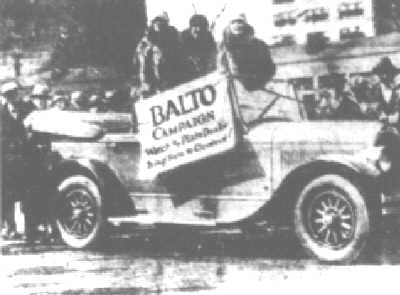 A Balto fund was established.
Across the nation, radio broadcasts appealed for donations.
Headlines in The Plain Dealer told of the push to rescue
the heroes. Cleveland's response was explosive. School children
collected coins in buckets; factory workers passed their hats;
and hotels, stores, and visitors donated what they could to the
Balto fund. The Western Reserve Kennel Club gave a needed
finantial boost. The people had responded generously. In just ten
days the headlines read, "City Smashes Over Top With Balto
Fund! Huskies To Be Shipped From Coast at Once!"
A Balto fund was established.
Across the nation, radio broadcasts appealed for donations.
Headlines in The Plain Dealer told of the push to rescue
the heroes. Cleveland's response was explosive. School children
collected coins in buckets; factory workers passed their hats;
and hotels, stores, and visitors donated what they could to the
Balto fund. The Western Reserve Kennel Club gave a needed
finantial boost. The people had responded generously. In just ten
days the headlines read, "City Smashes Over Top With Balto
Fund! Huskies To Be Shipped From Coast at Once!"
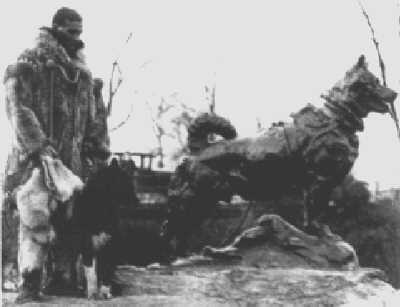 On March 19, 1927, Balto and six companions
were brought to Cleveland and given a heroes' welcome in a
triumphant parade through the Public Square. The dogs were then
taken to the Cleveland Zoo to live out their lives in dignity. It
was said that 15, 000 people visited them on their first day
there.
On March 19, 1927, Balto and six companions
were brought to Cleveland and given a heroes' welcome in a
triumphant parade through the Public Square. The dogs were then
taken to the Cleveland Zoo to live out their lives in dignity. It
was said that 15, 000 people visited them on their first day
there.
Balto died on March 14,
1933, at the age of 11. The husky's body was mounted at The Cleveland Museum of Natural
History, where it has been kept as a reminder of the gallant race
against death.
Back to Balto section
 Thanks to a bit of mis-information
and some curiosity on my part, I have obtained information as
well as pictures about what happened to the real Balto. The
following page includes several pictures (that may be viewed full
size) that were taken during the course of the 1925 "Mercy
Race to Nome".
Thanks to a bit of mis-information
and some curiosity on my part, I have obtained information as
well as pictures about what happened to the real Balto. The
following page includes several pictures (that may be viewed full
size) that were taken during the course of the 1925 "Mercy
Race to Nome".




